Fast Reconfigurable SOA-Based Wavelength Conversion of Advanced Modulation Format Data †
Abstract
:1. Introduction
2. Theory
2.1. Phase Noise and FWM
2.2. FWM with Dual Co-Polarized Pumps
3. Linewidth Characterization of SGDBR Pump Lasers for Wavelength Conversion
4. Experimental Setup for Reconfigurable Wavelength Converter
5. Results and Discussion
6. Conclusions
Acknowledgments
Author Contributions
Conflicts of Interest
References
- Chang, G.K.; Yu, J.; Yeo, Y.K.; Chowdhury, A.; Jia, Z. Enabling technologies for next-generation optical packet-switching networks. Proc. IEEE 2006, 94, 892–910. [Google Scholar] [CrossRef]
- Elmirghani, J.M.H.; Mouftah, H.T. All-optical wavelength conversion: Technologies and applications in DWDM networks. IEEE Commun. Mag. 2000, 38, 86–92. [Google Scholar] [CrossRef]
- Bhopalwala, M.; Rastegarfar, H.; Kilper, D.C.; Wang, M.; Bergman, K. Energy efficiency of optical grooming of QAM optical transmission channels. Opt. Express 2016, 24, 2749–2764. [Google Scholar] [CrossRef] [PubMed]
- Bayvel, P. Wavelength Routing and Optical Burst Switching in the Design of Future Optical Network Architectures; Proc. ECOC: Amsterdam, The Netherlands, 2001. [Google Scholar]
- Govind, P. Agrawal, Population pulsations and nondegenerate four-wave mixing in semiconductor lasers and amplifiers. J. Opt. Soc. Am. B 1988, 5, 147–159. [Google Scholar]
- Hu, H.; Jopson, R.M.; Gnauck, A.H.; Dinu, M.; Chandrasekhar, S.; Xie, C.; Randel, S. Parametric amplification wavelength conversion and phase conjugation of a 2.048- Tbit/s WDM PDM 16-QAM signal. J. Lightwave Technol. 2015, 33, 1286–1291. [Google Scholar] [CrossRef]
- Li, C.; Luo, M.; He, Z.; Li, H.; Xu, J.; You, S.; Yang, Q.; Yu, S. Phase noise cancelled polarization-insensitive all-optical wavelength conversion of 557-Gb/s PDM-OFDM signal using coherent dual-pump. IEEE J. Lightwave Technol. 2015, 33, 2848–2854. [Google Scholar] [CrossRef]
- Morshed, M.; Du, L.B.; Foo, B.; Pelusi, M.D.; Corcoran, B.; Lowery, A.J. Experimental demonstrations of dual polarization CO-OFDM using mid-span spectral inversion for nonlinearity compensation. Opt. Express 2014, 22, 10455–10466. [Google Scholar] [CrossRef] [PubMed]
- Lu, G.; Albuquerque, A.; Puttnam, B.; Sakamoto, T.; Drummond, M.; Nogueira, R.; Kanno, A.; Shinada, S.; Wada, N.; Kawanishi, T. Pump-linewidth-tolerant optical wavelength conversion for high-order QAM signals using coherent pumps. Opt. Express 2014, 22, 5067–5075. [Google Scholar] [CrossRef] [PubMed]
- Li, J.; O’Faolain, L.; Rey, I.H.; Krauss, T.F. Four-wave mixing in photonic crystal waveguides: Slow light enhancement and limitations. Opt. Express 2011, 19, 4458–4463. [Google Scholar] [CrossRef] [PubMed]
- Ettabib, M.A.; Lacava, C.; Liu, Z.; Bogris, A.; Kapsalis, A.; Brun, M.; Labeye, P.; Nicoletti, S.; Syvridis, D.; Richardson, D.J.; Petropoulos, P. Wavelength conversion of complex modulation formats in a compact SiGe waveguide. Opt. Express 2017, 25, 3252–3258. [Google Scholar] [CrossRef] [PubMed]
- Adams, R.; Spasojevic, M.; Chagnon, M.; Malekiha, M.; Li, J.; Plant, D.V.; Chen, L.R. Wavelength conversion of 28 GBaud 16-QAM signals based on four-wave mixing in a silicon nanowire. Opt. Express 2014, 22, 4083–4090. [Google Scholar] [CrossRef] [PubMed]
- D’Ottavi, A.; Iannone, A.; Mecozzi, A.; Scotti, S.; Spano, P.; Dall’Ara, R.; Eckner, J.; Guekos, G. Efficiency and noise performance of wavelength converters based on FWM in semiconductor optical amplifiers. IEEE Photonics Technol. Lett. 1995, 7, 357–359. [Google Scholar]
- Contestabile, G.; Banchi, L.; Presi, M.; Ciaramella, E. Investigation of transparency of FWM in SOA to advanced modulation formats involving intensity, phase, and polarization multiplexing. J. Lightwave Technol. 2009, 27, 4256–4261. [Google Scholar] [CrossRef]
- Kelly, A.E.; Ellis, A.D.; Nesset, D.; Kashyap, R. 100 Gbit/s wavelength conversion using FWM in an MQW semiconductor optical amplifier. Electron. Lett. 1998, 34, 1955–1956. [Google Scholar] [CrossRef]
- Anthur, A.; Watts, R.T.; O’Carroll, J.; Venkitesh, D.; Barry, L.P. Dual correlated pumping scheme for phase noise preservation in all-optical wavelength conversion. Opt. Express 2013, 21, 15568–15579. [Google Scholar] [CrossRef] [PubMed]
- Naimi, S.T.; Duill, S.P.O.; Barry, L.P. Detailed investigation of the pump phase noise tolerance for the wavelength conversion of 16-QAM signals using FWM. IEEE/OSA J. Opt. Commun. Netw. 2014, 6, 793–800. [Google Scholar] [CrossRef]
- Dúill, S.P.Ó.; Naimi, S.T.; Anthur, A.P.; Huynh, T.N.; Venkitesh, D.; Barry, L.P. Simulations of an OSNR limited wavelength conversion scheme. IEEE Photonics Technol. Lett. 2013, 25, 2311–2314. [Google Scholar] [CrossRef]
- Naimi, S.T.; Dúill, S.P.Ó.; Barry, L.P. Simulations of the OSNR and laser linewidth limits for reliable wavelength conversion of DQPSK signals using four-wave mixing. J. Opt. Commun. 2014, 310, 150–155. [Google Scholar] [CrossRef]
- Dúill, S.P.Ó.; Naimi, S.T.; Anthur, A.P.; Huynh, T.N.; Venkitesh, D.; Barry, L.P. Numerical generation of laser-resonance phase noise for optical communication simulators. Appl. Opt. 2015, 54, 3398–3406. [Google Scholar] [CrossRef] [PubMed]
- Anthur, A.P.; Watts, R.T.; Zhou, R.; Anandarajah, P.; Venkitesh, D.; Barry, L.P. Penalty-free wavelength conversion with variable channel separation using gain-switched comb source. Opt. Commun. 2015, 324, 69–72. [Google Scholar] [CrossRef]
- Anthur, A.P.; Watts, R.T.; O’Duill, S.P.; Zhou, R.; Venkitesh, D.; Barry, L.P. Impact of nonlinear phase noise on all-optical wavelength conversion of 10.7 GBaud QPSK data using dual correlated pumps. IEEE J. Quantum Electron. 2015, 51, 9100105. [Google Scholar] [CrossRef]
- Filion, B.; Ng, W.C.; Nguyen, A.T.; Rusch, L.A.; LaRochelle, S. Wideband wavelength conversion of 16 Gbaud 16-QAM and 5 Gbaud 64-QAM signals in a semiconductor optical amplifier. Opt. Express 2013, 21, 19825–19833. [Google Scholar] [CrossRef] [PubMed]
- Contestabile, G.; Yoshida, Y.; Maruta, A.; Kitayama, K. Coherent wavelength conversion in a quantum dot SOA. IEEE Photonics Technol. Lett. 2013, 25, 791–794. [Google Scholar] [CrossRef]
- Krzczanowicz, L.; Connelly, M.J. 40 Gb/s NRZ-DQPSK data all-optical wavelength conversion using four wave mixing in a bulk SOA. IEEE Photonics Technol. Lett. 2013, 25, 2439–2441. [Google Scholar] [CrossRef]
- Naimi, S.T.; Duill, S.P.Ó.; Barry, L.P. All Optical Wavelength Conversion of Nyquist-WDM Superchannels Using FWM in SOAs. J. Lightwave Technol. 2015, 33, 3959–3967. [Google Scholar] [CrossRef]
- Dúill, S.P.Ó.; Barry, L.P. Improved reduced models for single-pass and reflective semiconductor optical amplifiers. J. Opt. Commun. 2015, 334, 170–173. [Google Scholar] [CrossRef]
- Inoue, K. Polarization effect on four-wave mixing efficiency in a single-mode fiber. IEEE J. Quantum Electron. 1992, 28, 883–894. [Google Scholar] [CrossRef]
- Anthur, A.P.; Zhou, R.; O’Duill, S.; Walsh, A.J.; Martin, E.; Venkitesh, D.; Barry, L.P. Polarization insensitive all-optical wavelength conversion of polarization multiplexed signals using co-polarized pumps. Opt. Express 2016, 24, 11749–11761. [Google Scholar] [CrossRef] [PubMed]
- Hui, R.; Mecozzi, A. Phase noise of four-wave mixing in semiconductor lasers. Appl. Phys. Lett. 1992, 60, 2454–2456. [Google Scholar] [CrossRef]
- Blumenthal, D.J.; Bowers, J.E.; Rau, L.; Hsu-Feng, C.; Rangarajan, S.; Wei, W.; Poulsen, K.N. Optical signal processing for optical packet switching networks. IEEE Commun. Mag. 2003, 41, S23–S29. [Google Scholar] [CrossRef]
- Sadot, D.; Boimovich, E. Tunable optical filters for dense WDM networks. IEEE Commun. Mag. 1998, 36, 50–55. [Google Scholar] [CrossRef]
- Jayaraman, V.; Mathur, A.; Coldren, L.A.; Dapkus, P.D. Theory design and performance of extended tuning range in sampled grating DBR lasers. IEEE J. Quantum Electron. 1993, 29, 1824–1834. [Google Scholar] [CrossRef]
- Ward, A.J.; Robbins, D.J.; Busico, G.; Barton, E.; Ponnampalam, L.; Duck, J.P.; Whitbread, N.D.; Williams, P.J.; Reid, D.C.J.; Carter, A.C.; et al. Widely tunable DS-DBR laser with monolithically integrated SOA: Design and performance. IEEE J. Sel. Top. Quantum Electron. 2005, 11, 149–156. [Google Scholar] [CrossRef]
- Wesström, J.-O.; Hammerfeldt, S.; Buus, J.; Siljan, R.; Laroy, R.; de Vries, H. Design of a widely tunable modulated grating Y-branch laser using the additive Vernier effect for improved super-mode selection. In Proceedings of the 18th International Semiconductor Laser Conference (ISLC), Garmisch, Germany, 29 September–3 October 2002. [Google Scholar]
- Lin, Y.; Anthur, A.P.; O’uill, S.; Naimi, S.T.; Yu, Y.; Barry, L. Fast Reconfigurable SOA-Based All-Optical Wavelength Conversion of QPSK Data Employing Switching Tunable Pump Lasers; Proc. OFC: Los Angeles, CA, USA, 2017. [Google Scholar]
- Kikuchi, K. Characterization of semiconductor-laser phase noise and estimation of bit-error rate performance with low-speed offline digital coherent receivers. Opt. Express 2012, 20, 5291–5302. [Google Scholar] [CrossRef] [PubMed]
- Kyo, I. Polarization independent wavelength conversion using fiber four-wave mixing with two orthogonal pump lights of different frequencies. J. Lightwave Technol. 1994, 12, 1916–1920. [Google Scholar]
- Jia, L.; Chen, L.; Dong, Z.; Cao, Z.; Wen, S. Polarization insensitive wavelength conversion based on orthogonal pump four-wave mixing for polarization multiplexing signal in high-nonlinear fiber. J. Lightwave Technol. 2009, 27, 5767–5774. [Google Scholar] [CrossRef]
- Jonathan, L.; Mark, P.R.; Summerfield, A.; Madden, S.J. Tunability of polarization-insensitive wavelength converters based on four-wave mixing in semiconductor optical amplifiers. J. Lightwave Technol. 1998, 16, 2419–2427. [Google Scholar]
- Zhou, J.; Park, N.; Vahala, K.J.; Newkirk, M.; Miller, B.I. Four-wave mixing wavelength conversion efficiency in semiconductor traveling-wave amplifiers measured to 65 nm of wavelength shift. IEEE Photonics Technol. Lett. 1994, 6, 984–987. [Google Scholar] [CrossRef]
- Delorme, F. Widely tunable 1.55 μm lasers for wavelength-division-multiplexed optical fiber communications. IEEE J. Quantum Electron. 1998, 34, 1706–1716. [Google Scholar] [CrossRef]
- Seimetz, M. Laser Linewidth Limitations for Optical Systems with High-Order Modulation Employing Feed forward Digital Carrier Phase Estimation; Proc. OFC: San Diego, CA, USA, 2008. [Google Scholar]
- Jialin, Z.; Huijuan, Z.; Fan, L.; Yonglin, Y. Numerical Analysis of Phase Noise Characteristics of SGDBR Lasers. J. Sel. Top. Quantum Electron. 2015, 21, 1502009. [Google Scholar] [CrossRef]
- Camatel, S.; Ferrero, V. Narrow linewidth CW laser phase noise characterization methods for coherent transmission system applications. J. Lightwave Technol. 2008, 26, 3048–3054. [Google Scholar] [CrossRef]
- Huynh, T.N.; Nguyen, A.T.; Ng, W.C.; Nguyen, L.; Rusch, L.A.; Barry, L.P. BER Performance of Coherent Optical Communications Systems Employing Monolithic Tunable Lasers With Excess Phase Noise. J. Lightwave Technol. 2014, 32, 1973–1980. [Google Scholar] [CrossRef]
- Di Domenico, G.; Schilt, S.; Thomann, P. Simple approach to the relation between laser frequency noise and laser line shape. Appl. Opt. 2010, 49, 4801–4807. [Google Scholar] [CrossRef] [PubMed]
- Baveja, P.P.; Maywar, D.N.; Agrawal, G.P. Interband four-wave mixing in semiconductor optical amplifiers with ASE-enhanced gain recovery. IEEE J. Sel. Top. Quantum Electron. 2012, 18, 899–908. [Google Scholar] [CrossRef]
- Liu, L.; Tao, Z.; Yan, W.; Oda, S.; Hoshida, T.; Rasmussen, J.C. Initial Tap Setup of Constant Modulus Algorithm for Polarization De-Multiplexing in Optical Coherent Receivers; Proc. OFC: San Diego, CA, USA, 2009. [Google Scholar]
- Kikuchi, K. Performance analyses of polarization demultiplexing based on constant-modulus algorithm in digital coherent optical receivers. Opt. Express 2011, 19, 9868–9980. [Google Scholar] [CrossRef] [PubMed]
- Leven, A.; Kaneda, N.; Chen, Y. A Real-Time CMA-Based 10 Gb/s Polarization Demultiplexing Coherent Receiver Implemented in an FPGA; Proc. OFC: San Diego, CA, USA, 2008. [Google Scholar]
- Maher, R.; Millar, D.S.; Savory, S.J.; Thomsen, B.C. Widely Tunable Burst Mode Digital Coherent Receiver With Fast Reconfiguration Time for 112 Gb/s DP-QPSK WDM Networks. J. Lightwave Technol. 2012, 30, 3924–3930. [Google Scholar] [CrossRef]
- Simsarian, J.E.; Gripp, J.; Gnauck, A.H.; Raybon, G.; Winzer, P.J. FastTuning 224-Gb/s Intradyne Receiver for Optical Packet Networks; Proc. OFC: San Diego, CA, USA, 2010. [Google Scholar]
- Nakagawa, T.; Matsui, M.; Kobayashi, T.; Ishihara, K.; Kudo, R.; Mizoguchi, M.; Miyamoto, Y. Non-Data-Aided Wide-Range Frequency Offset Estimator for QAM Optical Coherent Receivers; Proc. OFC: Los Angeles, CA, USA, 2011. [Google Scholar]
- Mori, Y.; Zhang, C.; Igarashi, K.; Katoh, K.; Kikuchi, K. Unrepeated 200-km transmission of 40-Gbit/s 16-QAM signals using digital coherent receiver. Opt. Express 2009, 17, 1435–1441. [Google Scholar] [CrossRef] [PubMed]
- Dupre, J.; Stimple, J. Making OSNR Measurements in a Modulated DWDM Signal Environment. Available online: http://www.keysight.com/upload/cmc_upload/All/SLDPRE_2_OSNR_Measure.pdf (accessed on 8 October 2017).
- O’Dowd, J.A.; Shi, K.; Walsh, A.J.; Bessler, V.M.; Smyth, F.; Huynh, T.N.; Barry, L.P.; Ellis, A.D. Time resolved bit error rate analysis of a fast switching tunable laser for use in optically switched networks. J. Opt. Commun. Netw. 2012, 4, A77–A81. [Google Scholar] [CrossRef]
- Smyth, F.; Browning, C.; Shi, K.; Peters, F.; Corbett, B.; Roycroft, B.; Barry, L.P. 10.7Gbd DQPSK Packet Transmission Using a Widely Tunable Slotted Fabry-Perot Laser; Proc. ECOC: Torino, Italy, 2010. [Google Scholar]

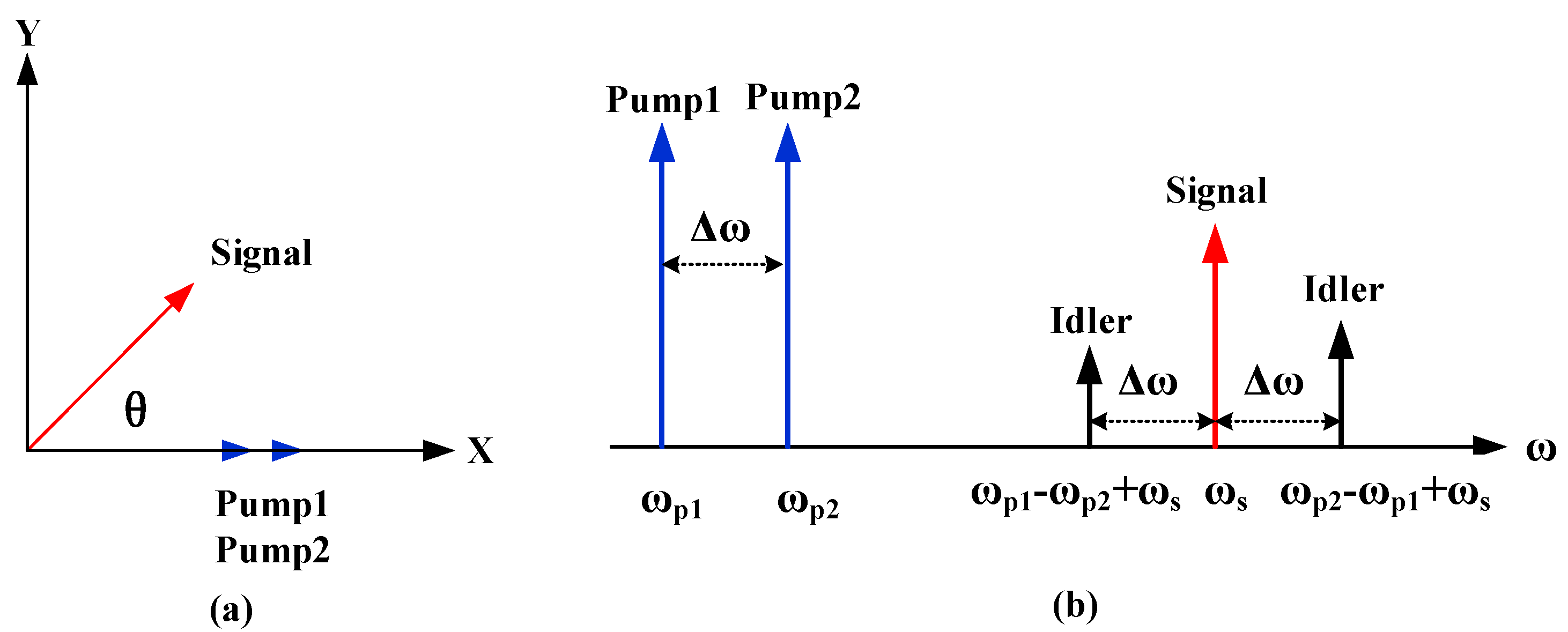

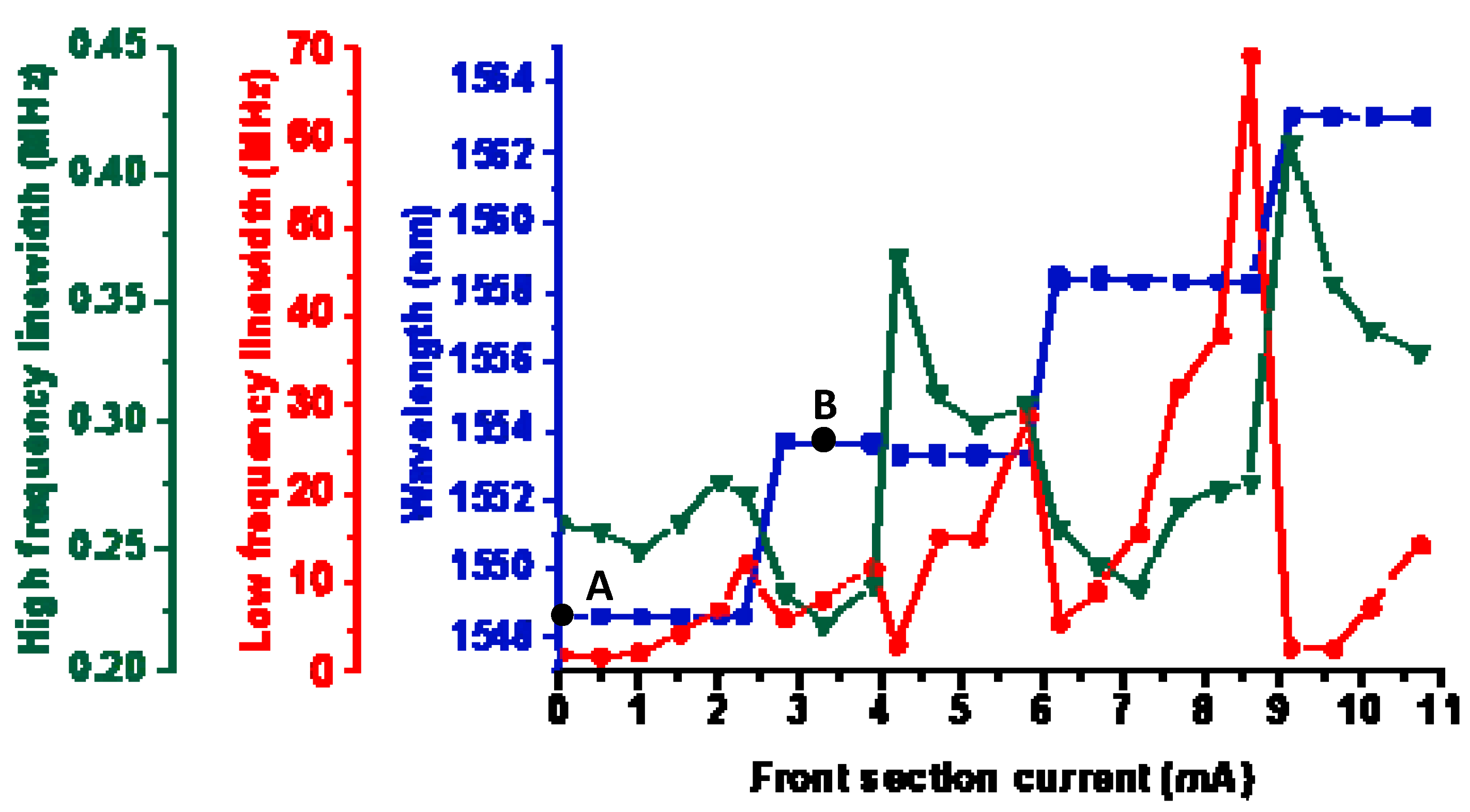
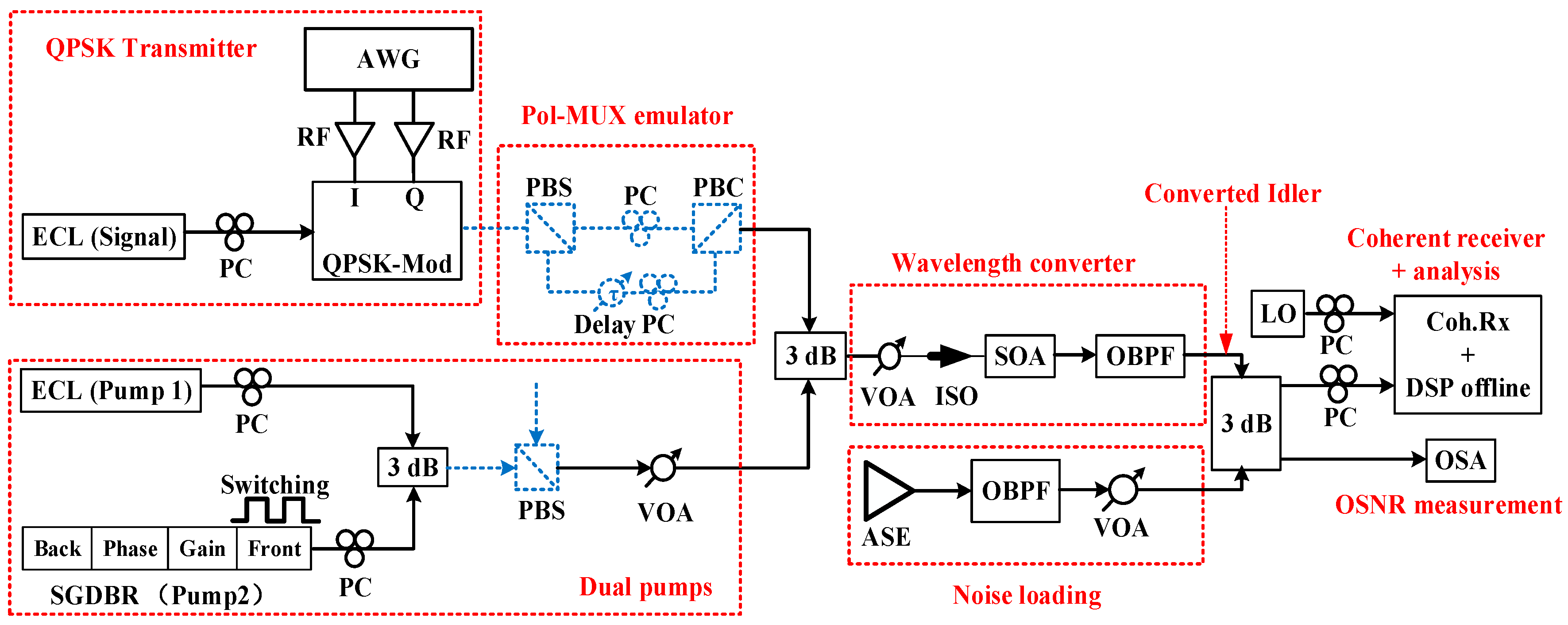
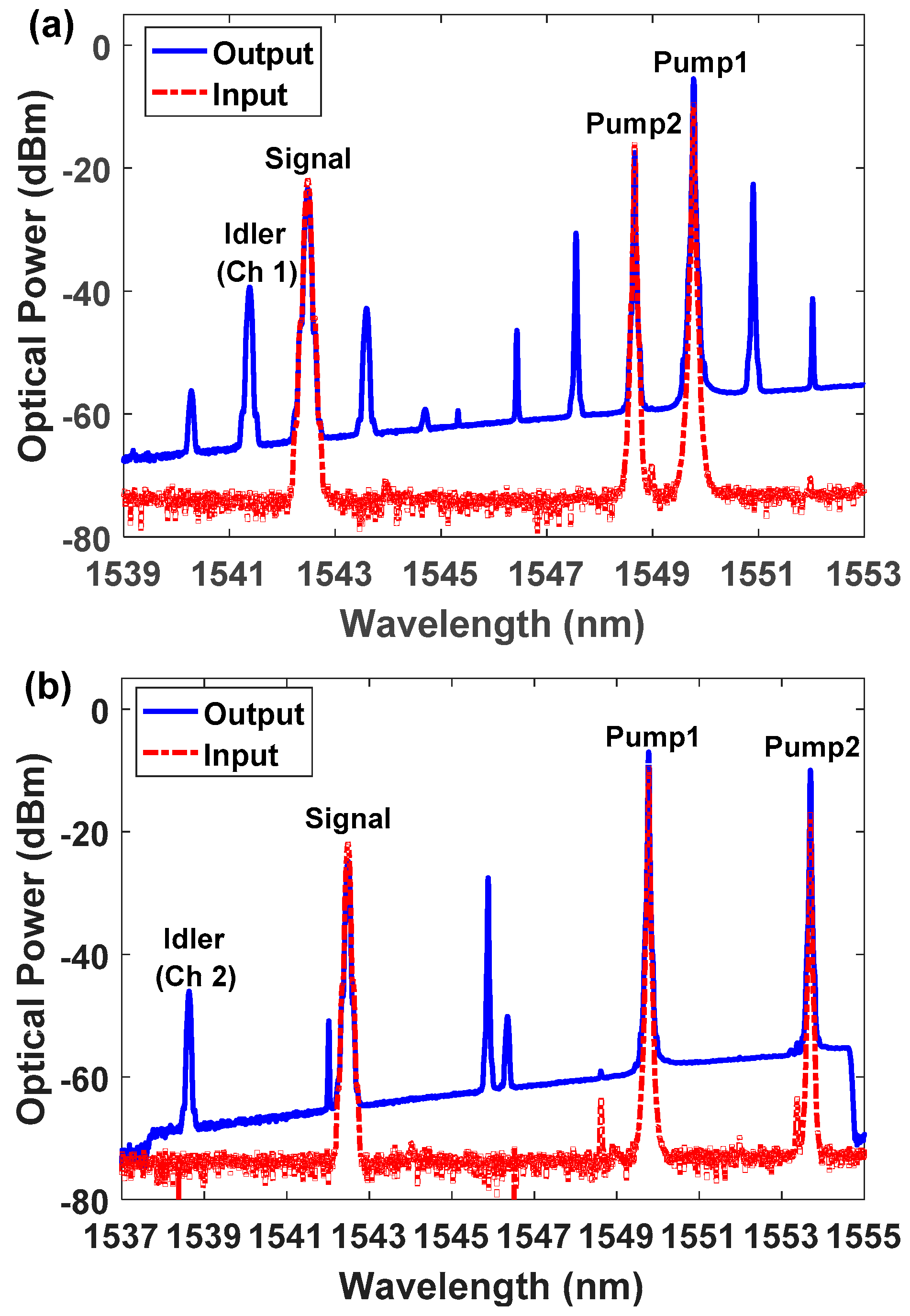
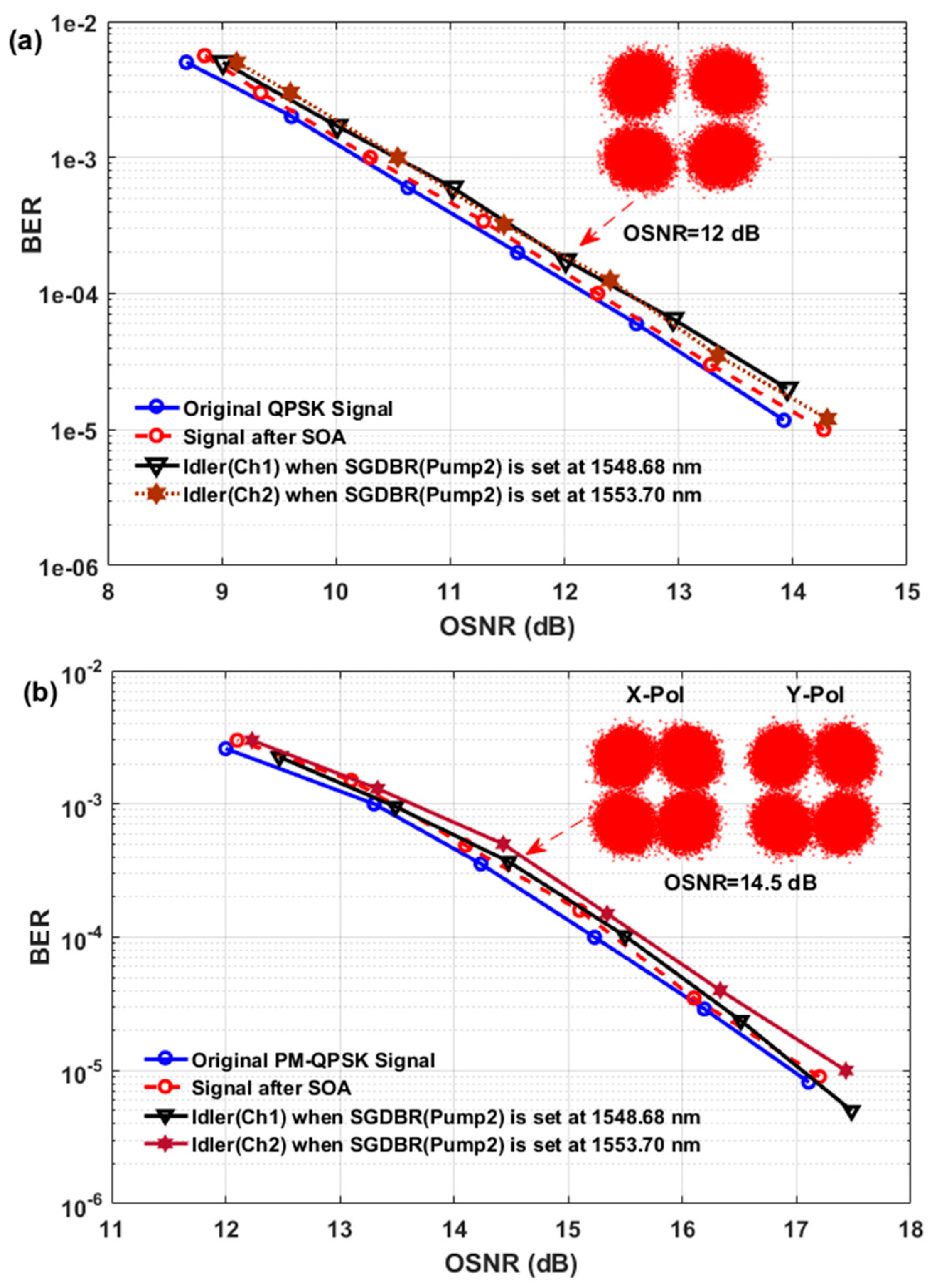

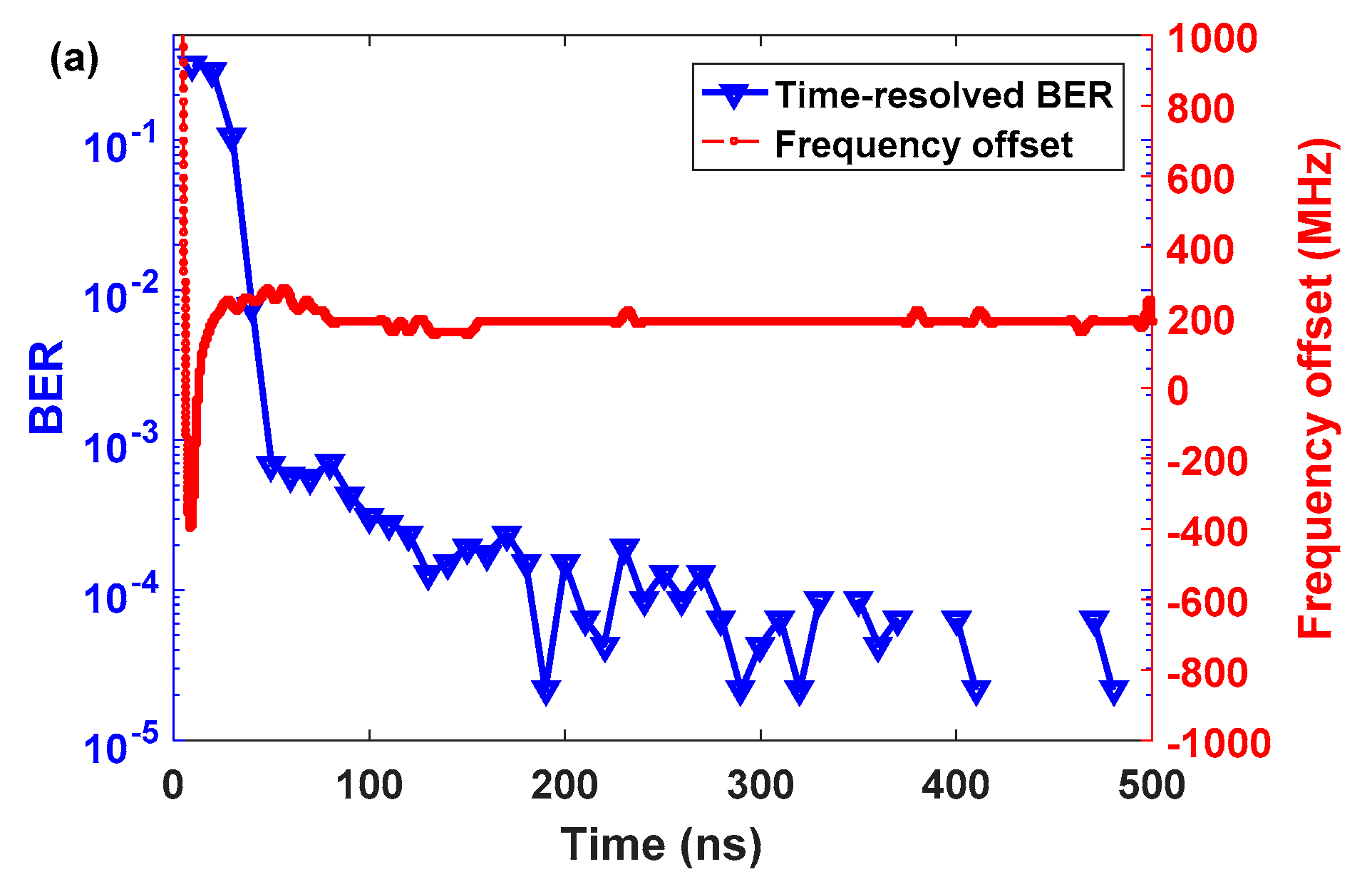
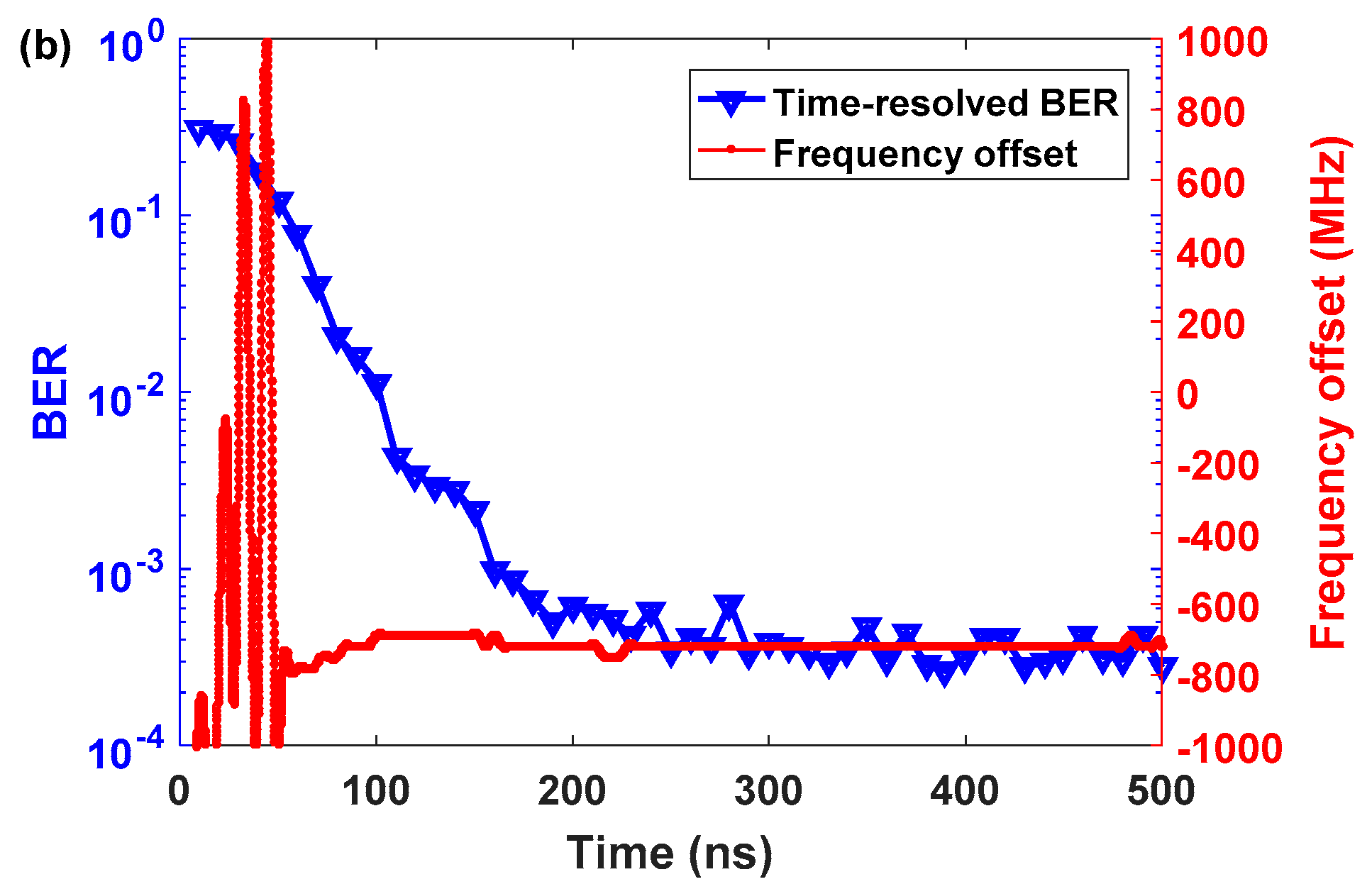
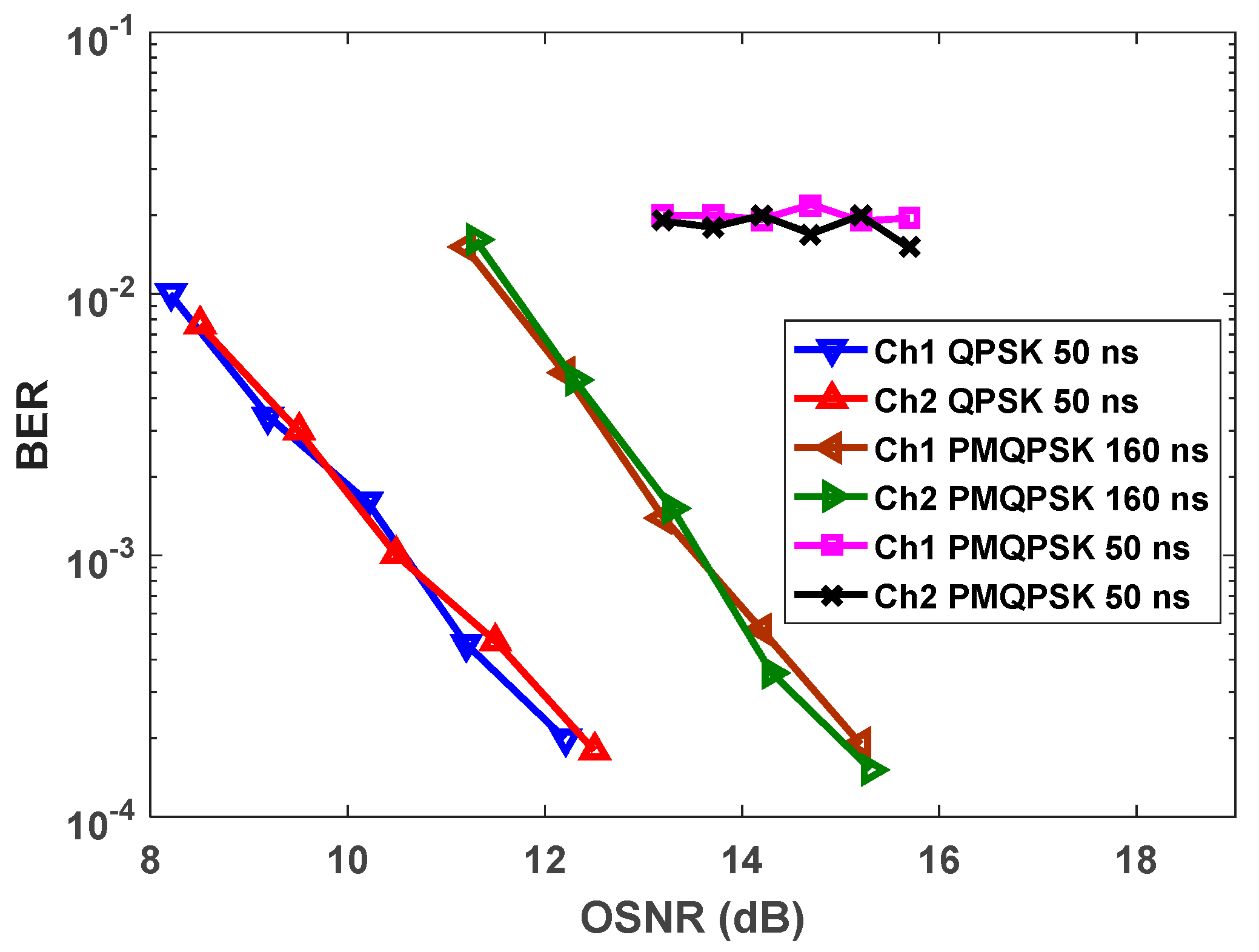
© 2017 by the authors. Licensee MDPI, Basel, Switzerland. This article is an open access article distributed under the terms and conditions of the Creative Commons Attribution (CC BY) license (http://creativecommons.org/licenses/by/4.0/).
Share and Cite
Lin, Y.; P. Anthur, A.; P. Ó Dúill, S.; Liu, F.; Yu, Y.; P. Barry, L. Fast Reconfigurable SOA-Based Wavelength Conversion of Advanced Modulation Format Data. Appl. Sci. 2017, 7, 1033. https://doi.org/10.3390/app7101033
Lin Y, P. Anthur A, P. Ó Dúill S, Liu F, Yu Y, P. Barry L. Fast Reconfigurable SOA-Based Wavelength Conversion of Advanced Modulation Format Data. Applied Sciences. 2017; 7(10):1033. https://doi.org/10.3390/app7101033
Chicago/Turabian StyleLin, Yi, Aravind P. Anthur, Sean P. Ó Dúill, Fan Liu, Yonglin Yu, and Liam P. Barry. 2017. "Fast Reconfigurable SOA-Based Wavelength Conversion of Advanced Modulation Format Data" Applied Sciences 7, no. 10: 1033. https://doi.org/10.3390/app7101033




